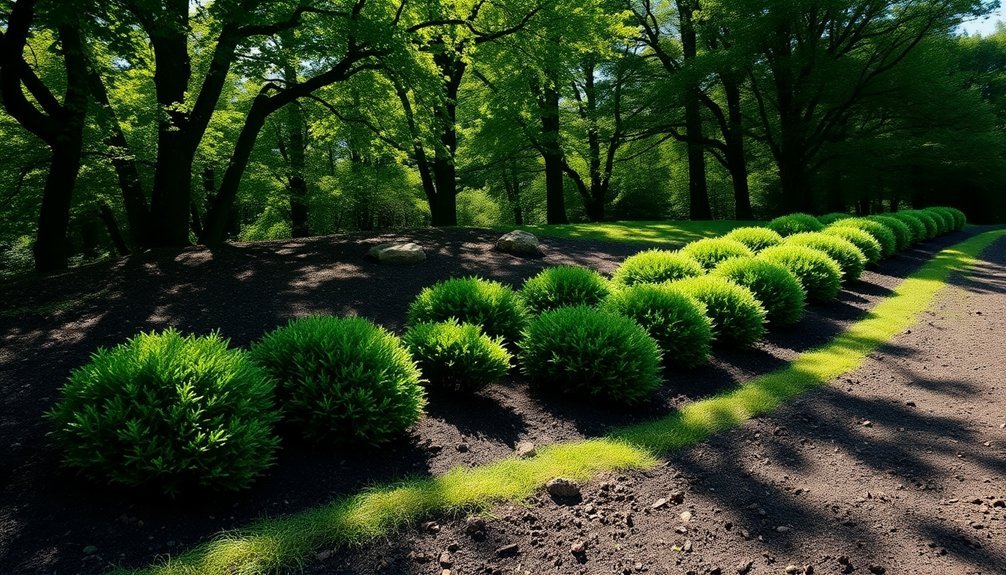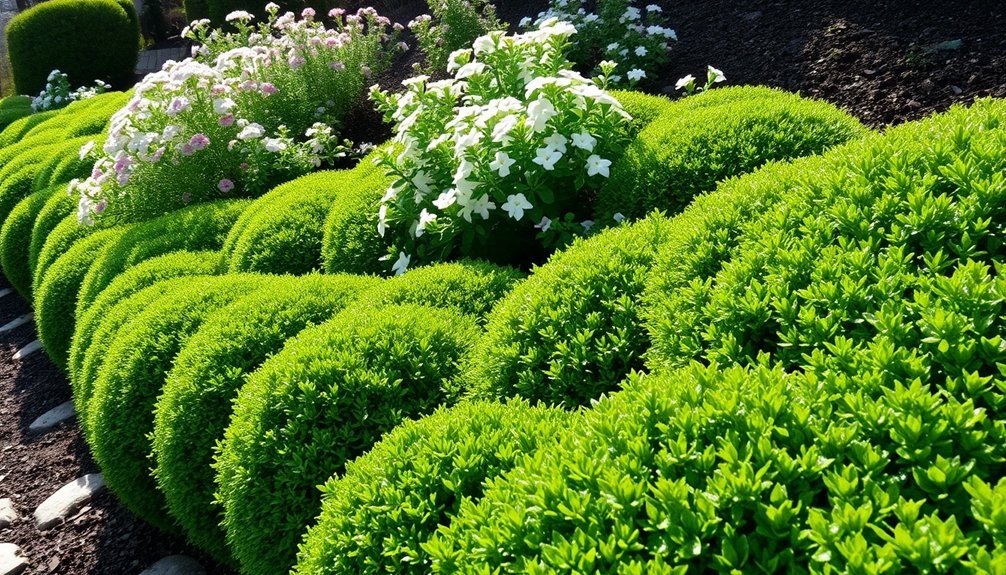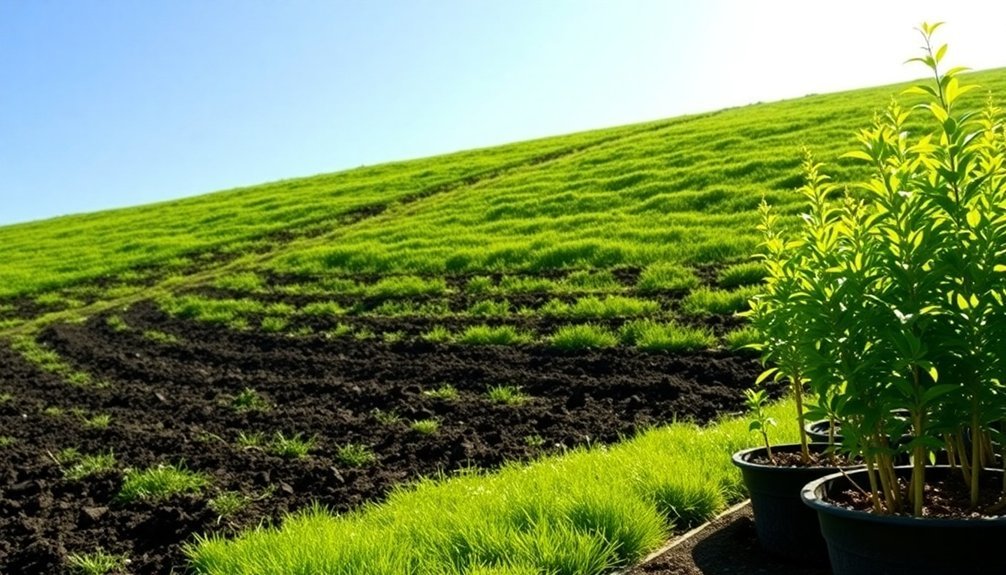Planting hedges on slopes requires careful preparation and species selection. First, assess your slope's steepness and soil type, then choose drought-tolerant plants with strong root systems like junipers or cotoneaster. Create small terraces or steps for planting, position plants at a slight angle toward the slope, and install a drip irrigation system to prevent erosion. Add 2-3 inches of mulch around plants to retain moisture. These simple techniques will transform your challenging terrain into a stable, beautiful landscape.
Understanding Your Slope's Characteristics

Before planting hedges on a slope, you'll need to thoroughly assess your terrain's unique features. Measure the degree of steepness, as this affects your hedge selection and whether you'll need retaining walls for stability.
Note the slope's orientation—sun-facing areas support different hedge varieties than shaded sections.
Sun exposure varies across slopes, dramatically influencing which hedge varieties will thrive in different sections of your landscape.
Examine your soil composition by grabbing a handful and testing its consistency. Sandy or loose soil may require stabilization techniques before planting.
Observe water drainage patterns after rainfall to identify potential erosion spots. Look for areas where water pools or runs off rapidly.
Don't overlook obstacles like rocks or tree roots that might interfere with hedge growth. These elements will influence your planting layout and might require removal or incorporation into your design.
Consider implementing terraced gardens on steeper inclines to create more manageable planting areas and improve overall landscape functionality.
Benefits of Hedges for Erosion Control
Hedges combat erosion through their robust root systems that firmly grip soil particles, preventing them from washing away during rainfall.
You'll find your property's water runoff considerably reduced as hedge roots create natural pathways for water absorption, effectively turning potential erosion into groundwater recharge.
When combined with ground-covering plants, hedges create a layered defense system that enhances slope stability while adding visual appeal to your landscape.
Root System Reinforcement
The powerful network of roots that hedges develop beneath the soil surface provides exceptional erosion control benefits for your property. As your hedges mature, their root systems grow deeper and more extensive, creating a natural mesh that binds soil particles together and increases ground stability.
When planting hedges on slopes, select species with fibrous root systems like vetiver or switchgrass. These plants develop dense root structures that anchor soil effectively and prevent mass failure during heavy rainfall. Their roots also create pathways for water infiltration, reducing surface runoff and the risk of gully formation. The strategic placement of hedges can reduce erosion rates by up to 2,000 times compared to exposed soil on construction sites.
For maximum soil reinforcement, combine hedges with low-growing herbaceous plants. This combination enhances water retention, prevents soil shrinkage, and creates a tiered root system that protects against multiple erosion factors.
Natural Water Management
When properly positioned throughout your landscape, hedges serve as natural water management systems that dramatically reduce erosion risks. They slow water runoff, trap sediment, and prevent soil from washing into nearby streams while absorbing pollutants that would otherwise contaminate water sources.
Plant hedges at the bottom of steep slopes, along watercourses, or across known runoff pathways to maximize their effectiveness. Cross-slope planting is particularly valuable for delaying flood peaks during heavy rain events. Planting hedges perpendicular to the slope will create a staggered pattern that effectively redirects surface water and minimizes erosion potential.
| Planting Location | Water Management Benefit |
|---|---|
| Steep Slopes | Captures runoff, prevents soil loss |
| Watercourse Edges | Filters pollutants, stabilizes banks |
| Runoff Pathways | Slows water flow, reduces flood risk |
You'll not only protect your property from erosion but also contribute to improved local water quality and sustainable landscape management.
Selecting the Right Hedge Species for Sloped Land

Choosing appropriate hedges for sloped terrain requires careful consideration of both aesthetic and practical factors.
Look for plants with drought tolerance and deep root systems like Siberian Cypress and Little Bluestem that effectively stabilize soil.
Evergreen options such as Virginia Creeper provide year-round erosion control, while low-maintenance varieties like groundcover roses reduce the challenge of caring for plants on difficult-to-access slopes.
Consider fast-growing species like Monkey Grass for quicker stabilization, or adaptable shrubs such as Dwarf Ninebark that thrive in various soil conditions.
For ideal results, implement layered planting by combining perennials, shrubs, and grasses.
Pay attention to sunlight requirements—Periwinkle Vine and Maidenhair Grass excel in partly shaded areas—and choose plants with strong winter tolerance if you're in a cold climate.
Plants like Pyracantha offer excellent hillside stability with their robust growth while providing showy flowers and berries, though their thorns should be considered when planning maintenance access.
Essential Tools and Materials for Slope Planting
Successfully planting hedges on sloped terrain requires specialized equipment that differs from flat-ground gardening. You'll need digging tools like shovels and trowels for creating terraces, along with measuring equipment to guarantee level planting.
Don't overlook safety gear—gloves and boots are essential when working on unstable ground. For steeper slopes, invest in specialized systems like the Dirt Locker or retaining wall materials for proper stabilization.
Your materials list should include appropriate hedge species, soil amendments for fertility, and erosion control elements such as geotextiles or mulch. Consider incorporating coarse mulch like chopped tree bark or straw which allows rain to penetrate while holding moisture on the slope.
Consider installing irrigation equipment with drip systems to maintain consistent moisture without causing runoff.
For long-term success, add support structures like stakes and mesh cages to protect young plants from both sliding soil and pest damage.
Preparing the Sloped Area for Hedge Installation

Proper preparation of your sloped area lays the foundation for thriving hedge plants that will remain stable for years to come.
Begin by addressing soil stability, mixing in organic amendments like well-rotted manure and slow-release fertilizers such as Blood, Fish, and Bone meal.
Nutrient-rich soil provides the essential foundation your hedge needs to thrive on challenging slopes.
Create water retention systems by digging small swales above where you'll plant. These trenches will capture runoff, allowing water to slowly infiltrate the soil where your hedges need it most.
Consider building soil berms around each planting hole to prevent erosion and retain moisture. Make sure to mark the site with wooden stakes and gardening twine to maintain consistent spacing between plants on the slope.
Apply a layer of coarse mulch like tree bark to suppress weeds and further reduce water loss.
For steeper gradients, terracing may be necessary to create level planting surfaces, ensuring roots develop at ideal depths while stabilizing the entire slope.
Step-by-Step Hedge Planting Technique for Slopes
Planting hedges on slopes requires six strategic steps to assure both stability and growth success.
Begin by digging holes slightly shallower than the root ball's height, allowing the crown to sit just above ground level. For smaller plants, position them at a slight angle to assure full root coverage while keeping larger trees upright.
Create a soil mound around each plant's base to form a water-retaining basin. Mix organic matter into your soil to improve drainage and quality. After placing plants, firmly compact soil around roots to prevent settling. On the uphill side of each plant, dig a hole and fill it with wood chips or rocks to create an efficient water delivery system.
Consider installing mini retaining walls using rocks or bricks around plant holes on steeper inclines.
Space plants appropriately to achieve interlocking growth while accommodating mature size. Remember to maintain proper spacing for a cohesive hedge appearance that won't become overcrowded over time.
Implementing Effective Water Management Systems

When managing water on sloped hedge plantings, you'll need strategic systems that prevent erosion while supporting plant health. Incorporate grass hedges at regular intervals (about 0.45m vertically) to effectively slow runoff and create zones of sediment deposition. Apply water to each plant individually by hand using a hose with adjustable pressure to ensure proper soil saturation without causing erosion.
For slopes over 15%, divert water flow diagonally into vegetated areas rather than allowing it to rush straight downhill.
- Create swales or berms that redirect water away from steep sections, preventing washouts and stabilizing your hedge planting.
- Establish vegetation barriers between hedge rows that increase surface roughness and considerably reduce flow velocity.
- Implement biotechnical soil stabilization by integrating your hedges with woody material, especially effective on slopes approaching 25%.
Mulching and Soil Stabilization Methods
Maintaining soil stability around your hedge plantings demands effective mulching techniques, especially on challenging slopes. Apply organic materials like straw or wood chips at appropriate thickness—enough to protect soil without washing away.
Proper mulching around hedges prevents soil erosion on slopes while nourishing your valuable plantings.
For slopes greater than 2:1, mulch immediately after seeding. You'll need to anchor your mulch using netting or pegs on steeper inclines to prevent displacement during heavy rains. Regular post-storm inspections are essential to identify and repair any wash-out or erosion issues promptly.
Consider implementing retaining structures or stone terraces for extremely steep areas where mulch alone won't suffice.
Choose erosion-resistant groundcovers to complement your hedges, creating multiple layers of protection. Hydraulic mulch, applied at 750 lbs per acre, works well for larger areas.
Remember to select locally sourced, biodegradable materials when possible. This sustainable approach improves soil health while effectively controlling erosion around your hedge plantings.
Maintenance Strategies for Hedges on Inclines

Successful hedge management on slopes requires specialized techniques that differ considerably from flat-terrain maintenance.
You'll need to adapt your trimming approach by working from top to bottom, using long-reach equipment, and following guideline strings for uniform results. Position yourself to trim across the slope for improved stability and safer working conditions. Water management is essential—implement drip irrigation systems that deliver moisture directly to roots without causing erosion.
- Monitor slopes regularly for signs of soil movement, addressing erosion immediately.
- Maintain consistent mulch layers (2-3 inches) to retain moisture and protect roots.
- Use lightweight equipment when possible to avoid creating depressions that collect water.
When trimming, adjust your cutting angle to match the slope gradient.
Don't over-prune, as this stresses plants and reduces their soil-stabilizing capacity. Remember to inspect for pests and diseases frequently, as stressed slope plants are particularly vulnerable.
Troubleshooting Common Slope Planting Challenges
Even the most carefully planned hedge plantings on slopes can face challenges like post-installation plant death, persistent soil erosion, and uneven growth patterns.
You'll need to quickly identify if dying plants result from inadequate watering, poor drainage, or improper planting depth—adjusting your maintenance accordingly.
When erosion continues despite your efforts, consider adding more substantial erosion control measures like jute netting or small retaining walls, while addressing uneven growth through selective pruning and targeted fertilization of struggling sections. Creating a proper small berm around each hedge plant can significantly improve water retention and reduce runoff problems on slopes.
Plants Dying After Installation
Despite careful planning, newly installed hedge plants on slopes sometimes fail to thrive, leaving gardeners frustrated and confused. The challenging slope environment creates unique stressors that can lead to plant decline even with proper initial planting techniques.
Common causes of post-installation plant death include:
- Poor species selection unsuited for slope conditions, resulting in plants that struggle from the start
- Water management issues—either drought stress from inadequate irrigation or root rot from poor drainage
- Environmental stressors like extreme temperatures, harsh winds, and excessive sun exposure
You'll need to quickly identify these issues through regular monitoring.
Check for signs of nutrient deficiencies, inspect for pests and diseases, and verify plants aren't suffering from mechanical damage from maintenance equipment or competition from aggressive weeds. One of the most critical factors is ensuring the uphill side of each plant's root ball is level with the soil to prevent planting too deep.
Soil Erosion Persists
When soil continues to wash away despite your newly planted hedge, you're facing one of the most frustrating challenges of slope gardening. This persistent erosion typically indicates that your current approach isn't sufficient for your slope's angle or soil conditions.
Consider implementing multiple erosion control strategies simultaneously. Add terracing or small retaining walls to break the slope into manageable sections.
Apply a thick layer of mulch between plants to protect exposed soil. Install straw wattles or erosion control blankets as temporary measures until your hedge establishes stronger roots. Strategically placing large boulders partially buried can create effective soil berms that prevent washout during heavy rains.
For severe cases, reassess your plant selection—you may need deeper-rooted varieties or additional ground covers between hedge plants.
Remember that steep slopes often require a combination of structural supports and vegetation to effectively combat erosion, especially during heavy rainfall events.
Uneven Plant Growth
Uneven plant growth throughout your hedge can transform what should be a uniform, attractive barrier into a patchy, irregular eyesore. This common challenge on slopes often stems from inconsistent soil conditions, varying sunlight exposure, or improper planting techniques.
To address this frustrating issue:
- Check for root interference from rocks or barriers that prevent proper establishment, then remove obstacles and amend the soil around struggling plants.
- Address shade variations by selecting species with similar light requirements or pruning overhanging vegetation to create consistent sunlight exposure.
- Test soil uniformity across your slope, as nutrient deficiencies in certain areas can dramatically impact plant development.
Regular monitoring is essential—catch growth disparities early by observing your hedge weekly during growing seasons.
You'll need to adjust watering practices for different sections, as slopes often create uneven moisture distribution. Consider cutting the lower sections of your hedge with a wider base than the top to ensure adequate sunlight reaches all parts of the plant.
Frequently Asked Questions
How Much Longer Do Hedges Take to Establish on Slopes?
Hedges on slopes will take you 30-50% longer to establish than on flat ground. You'll need extra patience as they typically require 3-4 years instead of the usual 2-3 years for full establishment.
Can I Plant Flowering Hedges on Steep Slopes?
Yes, you can plant flowering hedges on steep slopes. Choose drought-tolerant varieties with strong root systems like lavender or potentilla. You'll need to create swales or terraces to manage water runoff effectively.
Should I Stagger or Align Hedges When Planting on Contours?
When planting on contours, you'll get better erosion control and water retention by staggering your hedges. This technique distributes weight more evenly and creates a natural-looking barrier, while still following the contour line effectively.
How Do Deer and Rabbits Affect Slope-Planted Hedges?
Deer and rabbits can devastate your slope-planted hedges. Deer browse tops, weakening structure, while rabbits clip shoots and girdle stems. You'll need deer-resistant varieties and thorny barriers to protect your investment effectively.
When Is the Best Season to Plant Hedges on Slopes?
Early autumn is your best season to plant hedges on slopes. You'll give roots time to establish before winter, and you won't need as much watering as in summer's heat.
In Summary
Planting hedges on slopes isn't just practical—it's rewarding. You've now got the knowledge to transform challenging terrain into beautiful, functional landscapes. Remember to match your hedge choice to your specific conditions, establish proper water management, and maintain consistent care. With these techniques, you'll enjoy stable, thriving hedges that prevent erosion while enhancing your property's appeal for years to come.





Leave a Reply